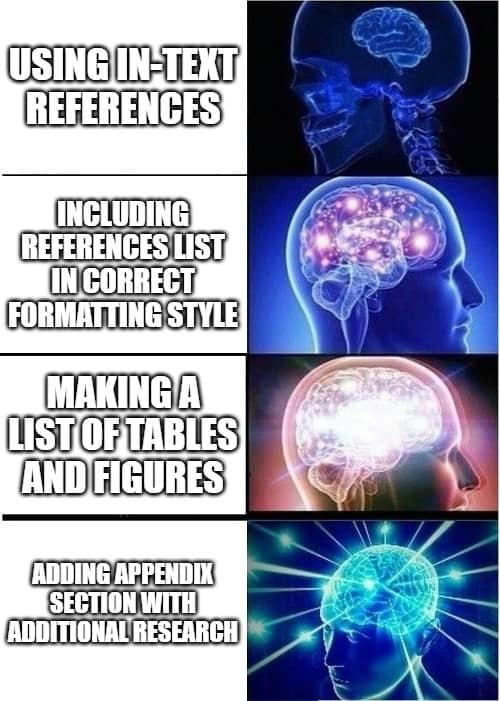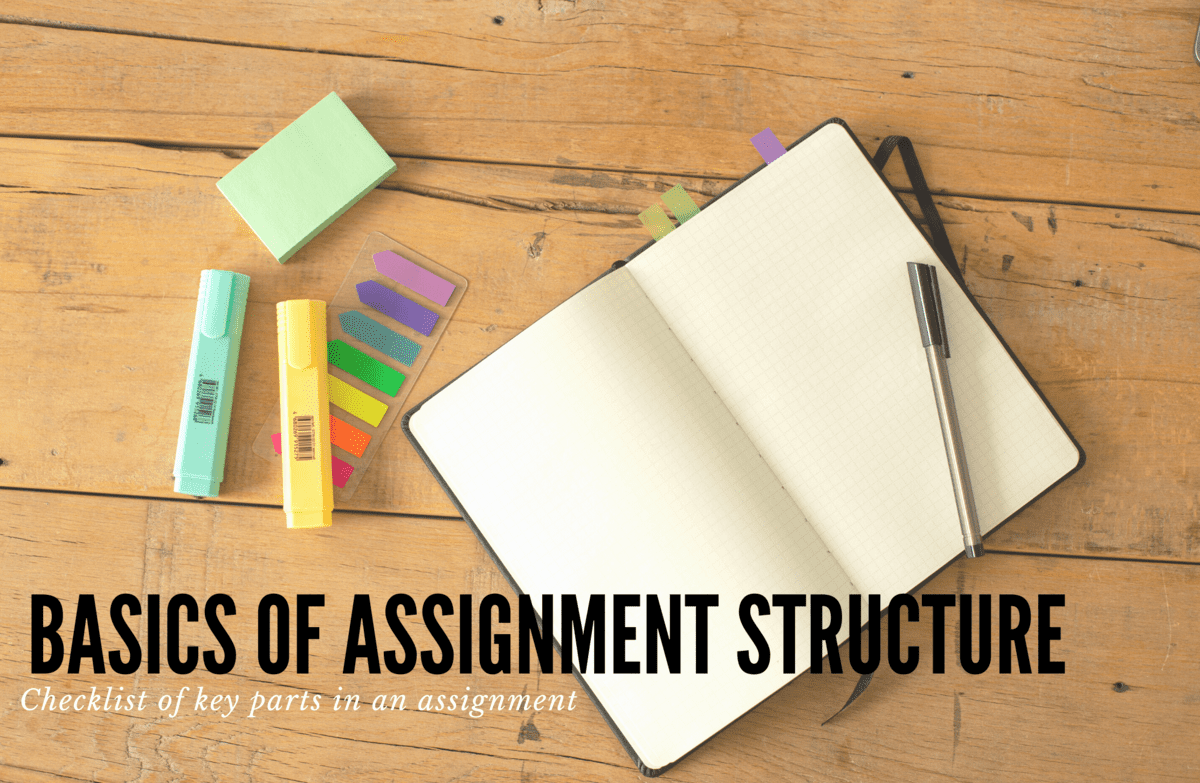Some students, particularly those in their freshman years, tend to overthink things and try to go for assignment structures that are unnecessarily complicated, thinking this will help them stand out from their peers and get better grades. It doesn’t have to be that hard.
This guide will give you an overview of basic assignment structure which you can use as a checklist for your assignments. This will help make sure that you haven’t missed any critical sections which are typically expected in assignment papers.
You will have to trust us when we say that your teachers will be really grateful that you’ve stuck to the standard format as it will make their grading process easier.
If you’re pressed for time, you can also head on over to our resources page to download some free assignment paper templates with generic outlines which you can tweak further to suit your needs. However, if you do happen to use any of these, then please ensure to follow our guide on checking document metadata details to avoid being flagged incorrectly for plagiarism.
Table of Contents
Overview of basic assignment structure
A very common advice is that any written work, which includes assignments, should have an introduction, a body, and a conclusion. This is a form of oversimplification but should you give you general idea of what is expected. In reality, academic writing requires additional subheadings under in the body or main part of your text to convey your ideas in a structured way.
So, here’s a more specific overview of the main structural parts of an assignment.
- Cover Page
- Table of Contents
- Introduction
- Literature Review
- Methodology
- Findings
- Discussion
- Conclusions
- References
We explain each of these in more details in the next sections
What are the essential parts in assignment structure?
The 4 parts of an academic writing work which should be considered essential are Introduction, Body, Conclusion and References. The last one should be obvious to any of our readers, but it’s surprising to see many students overlook the introduction and conclusion sections. Teachers often expect to see a short summary that sets the background and tone for the assignment, and they most definitely want to see what conclusions the student has reached by the end of their paper based on their study and research.

To make it simple, all you need do in the introduction is to give a brief overview of the topic which your paper is about, why this topic is relevant and important. In the conclusions section, you just need to summarize your research process, what you’ve learnt about the topic along the way and any final inferences.
These aren’t sections that you would have to do separate research for – if you’ve done your paper by yourself, you should be able to easily write a conclusion for it in no less than an hour (and we’re being very liberal with that estimation).
This is an easy to way to add in some additional words, which brings you closer to the required word count and reducing the words that you need to write for the other sections too, so why wouldn’t you want to do this, right?
As we have covered in our separate guide on how to manage word count of assignments, the introduction and conclusion sections are almost always included in the word count unless explicitly mentioned otherwise. You should be able to allocate about 200 to 300 words of the word count allowance to each of sections. This would cut down the amount of fresh content you need by about 400 to 600 words right off the bat!
Another critical section to be included in nearly all assignments would be a Table of Contents section. We have a full guide on how to easily make a good table of contents section which your teachers will be grateful to have when they are checking your work!
What are the circumstantial parts in assignment structure?
Moving on to the main part of your assignment, you could have a whole variety of headings and subheadings based on the type of paper that you are writing. Typically,
For thesis and dissertations, an Abstract section is almost always expected. Even if it hasn’t been specifically requested, we would highly recommend including this section for such long format papers because its purpose is to guide the readers with a ‘hook’ and make them more interested in reading your paper.
You can think of this section as a short summary of the main points from each of the broader headings in your paper. You don’t need to have more than 200 words for this section, and it shouldn’t be that hard to write as soon as you are done with your paper since the content that you’ve written should still be fresh in your mind.
The Rationale section is also expected in papers with longer word counts, especially those which are research oriented. In this section, you just need to explain the background of your chosen topic or research problem and why it is relevant and significant. You are expected to justify the need for your research on this topic. Some other research-oriented subsections include Research Aim & Objectives and Research Question, which you may potentially need, especially for long-form writing such as theses and dissertations.
Literature Review is a heading which can be considered as almost essential for most assignments since teachers want to see what external reading you have done on existing academic theory. The reason we have included this in the circumstantial section rather than the essential section above is because there are occasionally some assignments for which teachers explicitly mention not to define or explain academic theory and instead, they expect to see your understanding through direct application to the case.
This type of scenario typically arises when the word count for the assignment is not that high, so a full-blown literature review could be seen as ‘word-padding’ and have a negative impact on your overall grade for that assignment. We go over this issue of word-padding and how you can avoid it in a separate guide on managing word count as mentioned earlier.
A couple of sections that you can include in assignments where you are focusing on a particular industry or company are External Analysis and Internal Analysis respectively. As we cover in our guide on common academic words and what they mean, these are also known as Situational Analysis and Company Analysis, or Macro-analysis and Micro-analysis respectively. For company analysis, SWOT analysis one of the most common tools that are used, while another tool called TOWS is also occasionally used to combine internal and external analysis. Here’s a guide explaining the difference between SWOT and TOWS analysis.
Conceptual Framework is another circumstantial subsection which you may want to add if your research revolves around identifying independent and dependent variables.
For papers which require some research to be done as part of the assignment, you are going to need some sections like Methodology, Findings, Discussion and Analysis.
Within Methodology, you might have other subsections like Data Collection, Sampling Method etc.
What are some additional parts in assignment structure?
A section on Ethical Consent is often expected within the Research Methodology heading if your paper involves primary research gathered from respondents. We have a guide on ethical consent here and you can also check out our resources page to get a free sample ethical consent form which you could use in your papers (but be sure to also check out our guide on how to avoid getting flagged incorrectly for plagiarism so that you do not get wrongly flagged for plagiarism by using this sample form).
For research-oriented assignments, another typical expectation (although it isn’t always the case) is for a Research Timeline which illustrates the research process. This is often presented visually, and we have a separate guide on how to make good Gantt Charts easily using some of our free templates which you can find in our resources section.
Recommendations, and Limitations are also sometimes expected in some assignments, especially those that are long form, such as detailed research work.
If you have a lot of tables and figures in your work, which is usually the case for thesis and dissertations, you should also try to add a list of tables and figures (separate list for each).
Another section that you may wish to include in your assignments, especially if you have too many images or tables within your work, or if these are not to be included in the word count or in the body of the assignment, is the Appendix section. This is just a list of the additional content that is of direct relevance to your research adds to the quality and depth of your assignment. This section is typically not included in the word count allowance. Hence, it is often used to show that you have covered more ground in your research, but could not include it in main body due to word count limitation.

How to plan structure for essay assignments
Unlike standard academic reports, essays typically do not have subheadings but are instead expected to be structured in a logical way such that you transition from one idea to another by interlinking them.
However, we have come across some essay requirements in which the teachers have specifically asked for subheadings that indicate the central theme or idea which is being discussed in each section. If you are going to have subheadings in an essay though, then you should avoid numbering them as you would in other academic papers.
Taking assignment structures from the requirements files
Most teachers expect to see a standard structure in their assignments which helps them identify and assess the key learning outcomes of the module or the assignment. It is often the case that they will leave you some breadcrumbs by spelling out an assignment outline clearly within the requirements file, or in the presentations linked to the coursework, or perhaps during their lectures.
Sometimes, a structure would not have been defined clearly in the assignment requirements file, but there are ways to still get an almost explicit list of necessary headings such as by dissecting the marking guidelines which your tutors typically provide. We cover this in our guide on how to get better grades using a surefire method of drafting an outline which matches what the teachers are expecting.
Other teachers like to spice things up and give you free rein to structure your paper anyway you see it, but with this freedom of choice, you may find yourselves lost if you’re quite new to academic writing. In any of these cases, you can go over the upcoming list of standard sections and subsections that are present in academic papers to cross-check whether you have covered the relevant parts in your papers.

